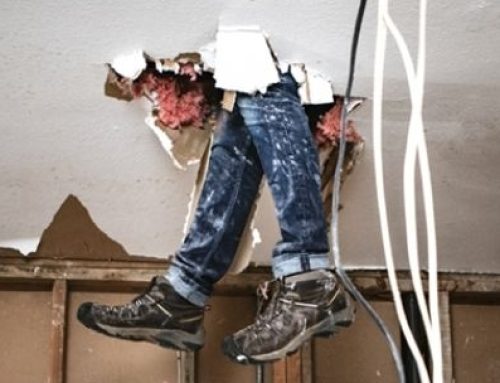Thinking about taking on a renovation? If there’s one thing to know about renovations, it’s that any substantial home improvement projects are not something to be taken lightly.
Try to undertake a renovation without the proper planning and you’ll likely come out of it with an insane amount of debt and a few screws loose… and not just the ones you forgot to order for the kitchen cabinets. Put simply, renovations are big jobs and can really take their toll — this is why your best bet is to get anything and everything in order before you even think about grabbing that wrench, calling the builders or ordering in the materials.
So, take a deep breath, make a cup of tea and I’ll take you through the 5 main steps to take when planning for a renovation.
1. Begin with preliminary research
First thing’s first, you need to have a good idea about what you want to achieve and how you’re going to achieve it. This is the ‘why’ and the ‘how’ of your renovation and it’s going to make up the backbone of the entire project.
If you have no idea where to start, a good place to turn is — you guessed it, the internet. Do a quick Google search on ideas relating to the plans you have in mind and try to nail down the look and feel that you’re going for. This step is essential regardless of whether you plan on doing small upgrades or you have big plans for a full blown reno, because when it comes down to it, if you only have half of an idea about what you want done, you’ll probably end up with a half-arsed result.
Do a heck ton of research, collect images, colour palettes, videos, articles, everything that’s relevant to your end goal. This task will not only help you visualise the aesthetics of your project, but it will also bring you closer to understanding the full scope of what is going to go into making it a reality.
This preliminary research will be your golden ticket towards the overall development and success of your renovation to come.
2. Budget, budget, budget
This is where we start getting into the nitty-gritty. If step 1 was dipping your toes in the water, step 2 is where you jump in head first. Money! Yep, that’s likely the biggest factor that’s going to determine the extent of this project, and this is where you will need to be brutally honest about what you can afford to achieve.
Where step 1 was more of a light-hearted dalliance of colourful pictures and day-dreaming, step 2 is going to be hard numbers on a blank page. This is where the real work begins and the time where you need to put your head down and bust out that calculator you thought you’d never have to use outside of tax time.
Renovations are no small task… even the small ones! So it’s going to be essential that you budget wisely, and do NOT go beyond your available funds. Try to be as realistic and conservative as you possibly can because underestimating the cost of a project can put you in some seriously hot water. As a rule of thumb, it’s a good idea to budget around 45-50% for the cost of your materials, 30-35% will likely go towards labour costs, and expect 20-25% to be spent on taxes, levies, GST, etc.
3. Create a final renovation plan
This is it, my friend. Step 1 and 2 were just child’s play; this is where the heavy lifting comes in — heavy brain lifting that is. At this stage you should now have a fairly solid idea about what you want your renovation to achieve, what it’s going to look like, and how much it’s going to cost. Now is the time to put all of this information together in one place and develop a finalised renovation plan.
Not only will this include a detailed list of your expenses and exactly where they are going, it should also include any blueprints, sketches or visual aids that will be needed to fully actualise the finished results. Last but not least, you’ll want to set out the necessary steps to take moving forward and separate which tasks you’ll be performing on your own, and those that will require the help of a professional.
How you go about putting this heroic selection of material together is entirely up to you, but I will say one thing; there’s a good reason why some people can’t live without spreadsheets… They are pretty darn handy.
4. Start planning far in advance
If you know anything worth knowing about renovations, you’re likely aware that they aren’t something that can be done in an afternoon. Saying that there’s a lot to consider is an understatement if I ever did hear one. So it should come as no surprise that planning ahead is going to be a necessity as it could mean the difference between complete success or total failure… and if you’re lucky enough to avoid failure, thoughtlessness and indifference might end up costing you way more than you budgeted for.
Renovations need to be scheduled in advance so that everything and everyone you need to make it happen can all come together at the necessary time. Scheduling helps all the pieces to align so that you have all the materials on hand, all the tradespeople booked in, and you can aim to get the job done before any significant deadlines — such as the end of a settlement period or the date you put your house back on the market.
There’s no hard and fast rule for how much time to allot for renovation planning and it’s going to depend quite heavily on the size of the project, the materials you need to order in, and how organised you are in your day-to-day life. Some experts would recommend 6-12 months if we’re being conservative whereas others would say 6-8 weeks. I would suggest that if you have serious plans to renovate, I would give yourself a solid 2 months to sort everything out at the minimum. Sometimes it doesn’t matter how organised you are, it could just depend on how generous the home improvement Gods are feeling at that time.
5. Pack Up and Prepare for Your Home Renovation
One last step.
You’ve been planning this project from the inside-out for weeks on end and you now know exactly what to expect. You’ve budgeted your little heart out, everything is ready to go, the builders are booked in, the materials are on their way… is that it?
What’s going to happen when the time comes for renovations to actually begin? How will you live through this? And I don’t mean emotionally (although I did go through how to avoid losing your mind during a renovation here), I mean practically.
This is a step that can often get overlooked when all of your mental faculties are occupied with planning the renovation itself. So let’s go through the logistics; where is the renovation taking place? Will you have access to the basic facilities of your house? Will you still be able to use your kitchen or bathroom, will you have a place to sleep?
Depending on the size and scope of your renovation, you may need to set up a temporary place to cook and clean dishes, hire a portable toilet, or possibly set up an unconventional place to sleep for some time. Another thing to consider is whether you will need to store any furniture or other items away for safekeeping and how much space you’ll need to be able to do that.
If you have the means, a good alternative to dealing with the insanity of home renovations is to move out completely and stay with a friend or family member for the project’s duration. This way you can completely remove yourself from any ear splitting cacophonies and clunky makeshift living space alternatives while periodically checking back in to make sure things are running smoothly.
Conclusion
Taking on a renovation is no easy feat. It takes some serious brain power and a lot of hands to bring something that large and complex to life. This is where the power of planning comes in and where all of your fantasies and day-dream musings get turned into hard data and tangible results. Keep all this in mind and there should be very little to keep you from having a dream renovation scenario at your fingertips, but if there’s any advice I would leave you with it would simply be, never underestimate the value of a detailed plan when it comes to the success of your next renovation.







Leave A Comment